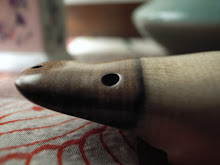
When were you punched last time? Have you ever been kicked by someone? Was it a serious incident? Were you just physically playing with some of your friends? It is a rare occasion for modern adults, who live a safe and secure life, to punch or kick someone else. It is rarer to do so in public. Only some professionals fight with each other in front of audience because they need to earn income by doing so. Thanks to those fighters, we can imagine how it would be to punch or kick others. How would you feel, then, if you are waiting for a friend of yours at a station and notice that a bunch of youth next to you suddenly start hitting and kicking each other?

Frighten? Excited? or do you hate it? I
do not know how you would react to it, but I am sure that you cannot help paying an attention to the youth. You cannot disguise that you are totally uninterested in their punching and kicking with each other. Physical contact is so attractive and convincing that it is difficult to refuse to witness it.

contact Gonzo is a group of four young, male
artists (for the performance I witnessed), who occasionally punch and kick with each other in public as a performance. You would for the first glance believe that they are fighting with each other. No wonder you are led to believe so because they actually do harm with each other. But what they are doing is touching with each other as claimed by those youth. It is a manifestation of an art, say, the art of touching.
 What is the art of touching? The notion of touching is provocative. It is a great leap for the modern adults to touch someone else physically when you have no particular reason. You need a reason when you touch someone. You may touch someone's chest to diagnose his condition if you are medical doctor. You may touch someone's back if you are asked to massage her. We accept her touching you if she does it as part of her job. We seem to allow someone to touch you if it has a purpose or a rational. What I think of as a reason for touching has something to do with care or an intended action for healing someone else.
What is the art of touching? The notion of touching is provocative. It is a great leap for the modern adults to touch someone else physically when you have no particular reason. You need a reason when you touch someone. You may touch someone's chest to diagnose his condition if you are medical doctor. You may touch someone's back if you are asked to massage her. We accept her touching you if she does it as part of her job. We seem to allow someone to touch you if it has a purpose or a rational. What I think of as a reason for touching has something to do with care or an intended action for healing someone else. Touching is often healing or helping some others. We even pay him sometimes if he touches you for good reason. Okay, good. Now let turn to their performance. Are they touching with each other? Yes, because punching is touching. Then, next question. Are they healing each other? Well, they might be doing it as a ceremony to expel a bad spirit of their bodies. I believe that Zen Buddhists appreciate being hit while meditating if they do not concentrate on them. Contact Gonzo does it as a spiritual exercise. Are you persuaded? No, I am not, neither. (to be continued)
Touching is often healing or helping some others. We even pay him sometimes if he touches you for good reason. Okay, good. Now let turn to their performance. Are they touching with each other? Yes, because punching is touching. Then, next question. Are they healing each other? Well, they might be doing it as a ceremony to expel a bad spirit of their bodies. I believe that Zen Buddhists appreciate being hit while meditating if they do not concentrate on them. Contact Gonzo does it as a spiritual exercise. Are you persuaded? No, I am not, neither. (to be continued)











